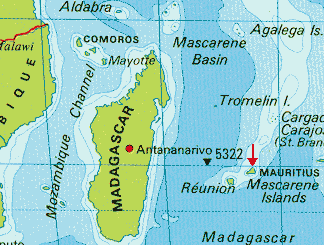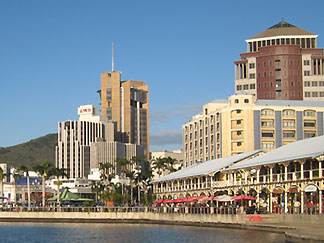|
Brief histories of the
first clubs of each geographic regions or countries
Rotary Club of PORT
LOUIS,
the First Club of Mauritius
Rotary International
District 9220
A Part Our History of Rotary in
Africa

 This is a short extract of a
voluminous and exceedingly interesting history covering over 40 pages of
events. The history of Port Louis is probably the most comprehensive history
of any Rotary Club in the world (webmaster)
MAY 1964 TO JUNE 1965
The inaugural President appointed upon the formation of the club
was Anauth Beejadhur
other officers and members of the club are recorded with their
classifications:-
- Allan Bates 1st Vice-President
- André Robert 2nd Vice-President
- José Poncini Secretary
- Maxime Seriès Treasurer
- Robert Antoine (Sugar Industry: Research)
- Archibald Archibald (Engineering: Civil Engineering)
- Allan Bates (Finance: Development Banking)
- Anauth Beejadhur (Printing and Publishing: Newspaper Publishing)
- Carrim Currimjee (Real Estate: Renting - Proprietary)
- C1ément Dalais (Construction Service: Building Construction)
- Ebrahim Dawood (Food Industry...Food and Grain)
- Fernand Espitalier-Noël (Medicine: Surgeon)
- Louis Espitalier-Noël (Transportation: Travel Agency)
- James D. Grieg (Government: Taxation)
- Radhamohun Gujadhur (RealEstate: Land Investment)
- Pierre Hugnin (Beverages, Non-Alcoholic: Carbonated Beverage
Manufacturing)
- H.R. Hurd (Government: Taxation)
- H. Kux (Construction Service: General Contracting)
- Marcel Lagesse (Glass Industry: Mirror Manufacturing)
- Henry Latham-Koenig (Law: Notary Public)
- Commander Lavender (Government: Public Defence, Sea)
- Philippe Lenoir (Beverages, Alcoholic: Wine Distributing)
- Philippe Lim (Hotels and Restaurants: Restaurants)
- Amédée Maingard de Ville-es-Offrans (Transportation: Air
Transportation)
- Claude Obeegadoo (Education: Private Schools)
- B.B Panray (Business Services: Patents & Trade Marks)
- Michel Pitot (Hotels and Restaurants: Hotels)
- José Poncini (Horology: Watch Servicing and Retailing)
- Abdool Raman (Medecine: Psychiatrist)
- André Robert: (Law: Solicitor)
- John Schoon-Wagen (Government: Tourist Promotion)
- Phillip Scott (Sugar Industry: Sugar Milling)
- Maxirne Seriès (Fruit, Vegetables & Nut Products: Importing and
Distributing)
- Kistnassamy Sunassee (Dry Goods & General Merchandise: Variety
Store)
As of May 13, 1964, the Rotary Club of Port Louis began regular weekly meetings On Wednesday -
alternating between lunch in Port Louis at 12.30 p.m. at La Flore Mauricienne, and drinks in Curepipe at 6 p.m. in the Park Hotel
attic. However, the evening meetings were sparsely attended and so, from August, all weekly meetings were held at lunchtime
in Port Louis.
Pending official recognition by Rotary International (R.I.), the founding members got down to
the fundamentals -
* Marcel Lagesse took on the design of a club banner, which Maxime Seriès had made in South Africa;
* Badges were ordered from the United States;
*
"Fritz" Kux fashioned a club gong.
*
José Poncini maintained a flow of correspondence with R.I. headquarters and submitted the club's application for admission. He also was in continual contact with the Rotary Club of Tananarive, which was to sponsor the Club's application.
Of all the founders, only Bates and Archibald - both expatriates - had been Rotarians previously;
*
Bates was even a Past-President (PP) of the Rotary Club of Cyprus.
*
"Busic" Espitalier-No61 had informed himself about Rotary during visits to Europe and Madagascar,
*
Maxime Seriès similarly in South Africa.
At the other extreme in the early days were those prospective members skeptical or misinformed and even opposed: to them
Rotary meant only convivial eating/drinking get-togethers; or a group of domino players; or perhaps, some kind of secret
society with passwords and regalia.
In addition to overcoming this local diffidence, the fledgling club had a basic bureaucratic
problem to solve with R.I. prior to winning its approval. R.I. couldn't understand why it was called the Rotary Club of Port
Louis, when most of its members lived elsewhere, principally in Plaines Wilhems.
(R.I. regulations require that the club's name coincide more-or-less with
the place of residence of its members)
To avoid further delay, R.I. agreed to allow all of Mauritius to be included in the territory of the Port Louis Club. Therefore,
any new club on the island would need its permission and corresponding cessation of area. With this compromise, the path towards
recognition was cleared and this was notified by a telegram received by the Secretary on November 10, 1964.
Then came the memorable day, November 24th, when the club charter was symbolically presented.
A banquet at the Vatel brought together the entire club membership and the colony's most distinguished officials:
*
H.E. Tom Vickers, the acting Governor;
*
Dr. Seewoosagur Ramgoolam, Prime Minister;
*
the Chief Justice and Speaker of the Legislative Assembly and other cabinet ministers;
*
the Bishops of Port Louis and of Mauritius;
*
members of the consular corps;
*
Rtn. Le Goff and another member of the Rotary Club of Tananarive;
*
Dr. Hassen, president of the Rotary Club of St. Denis (R6union) and three other members.
The official speeches were presented by District Governor (DG) John Longman of Rotary District 220, who also represented R.I.
and presented the charter; and
-
Rtn. Le Goff of the sponsoring club; and of course,
-
Founding President Anauth Beejadhur.
Shortly after, in January 1965, the club in line with Rotary practice, began publication of a
monthly bulletin, with Rtn. Archibald as first editor. (Unfortunately, regular issue of a bulletin has been a constant club
problem still unresolved at this writing).
Another peculiarity at birth of the Port Louis Club was that it was "undistricted".
R.I. consists of individual clubs, which are normally grouped in neighbouring districts under a "District Governor".
But because of their relative isolation, some clubs are not included in any district, but depend directly on R.I. headquarters
in the U.S.A. Such was the situation in 1964 of Reunion and the Comoros. Nearby Madagascar clubs were part of District 220,
which also took in the English-speaking clubs of Ethiopia, Kenya, Uganda, Tanganyika (later Tanzania), Zambia and Malawi
(since transferred to District 225). The initial position of the Port Louis Club was to follow the example of those in Reunion
and the Comoros. As we shall see, it wasn't until Rotary year 1967-68 that the change came.
The 1965/66 year was still the "teething period" for Rotary in Mauritius. For example, only the
Community Service and International Service Committees were specifically set up. As for the Club Service Committee - in view of
the small number of experienced members - the Board of Directors decided to assume itself the functions and duties of this
committee. For the same reason, it was considered inadvisable to organize a Vocational Service Committee, the more so since
even greater information, advice and experience were needed in the Board's opinion. Not surprisingly, therefore the initial
tendency remained to concentrate the club's limited resources in men (38) and means on Community Service, for which two major
projects were envisaged.
The first raised funds, which were donated to the Repas des Pauvres, a charitable organization
in Port Louis providing food for the poor, and especially, the disabled.
Two distinguished Rotarians visited the island during this period and their expert counsel proved of inestimable value
to the neophyte Port Louis Club. One was Kendall Young, of the United States, then serving as the R.I. Board of Directors liaison
for districts in the Southern Hemisphere. Young came principally to sell the Port Louis club on the idea of joining District
220, but his most valuable contribution was the sharing of his long experience in Rotary. President André recalls an amusing
anecdote of this visit:
"Young arrived by air after a tiring day in St. Denis and it was nearly 11 p.m. when I
accompanied him to the Park Hotel in Curepipe. I offered him a drink, which he refused. I then tried coffee or tea and he
still refused. He thereupon explained that he was of the Mormon faith and forbidden to consume alcoholic or stimulant drinks.
He did want water - to take a bath - but not a drop came out of the faucet - although it was raining abundantly outside."
The second visitor during November was Anant Pandya, of Kenya, the current District 220 Governor..
He, too, came to try to get the Port Louis club "districted".
Young also helped to settle one troublesome question: should the Rotary Club of Port Louis
prepare a Memorandum and Articles of Association in order to become a "body corporate" and thus, obtain legal status in
Mauritius? To President André, himself a solicitor, and Rtn. Redmond Hart de Keating, a notary, the answer appeared to be
in the affirmative. But Young was definitely negative. Each club, he argued, is considered to be covered by the Constitution
and By-Laws of R.I. itself. So, the plan was dropped and if the Rotary Club of Port Louis is anything by Mauritian legal standards,
it must be in the partnership/joint venture category.
As part of an R.I. project to incorporate into a new headquarters in Evanston, Illinois, pieces of stone from every country
with a Rotary Club, Port Louis had a block of blue basalt prepared, which was shipped in August 1966.
It is recorded that, at a Board meeting on April 27th 1966, it was suggested that a club history be published every year,
with a listing of members and their classifications. No club history was ever prepared before this one ...
In the 1966/67 year, the number of members had grown from 38 to 53, although the Board had fixed a top limit of 50.
The most memorable and meaningful project of the year involved literally hundreds of school children in Mauritius and Australia. It all started when the Northam, West Australia, Rotary Club sent over to the Port Louis club a large parcel of art, handicrafts, and written material prepared by primary school children illustrating various aspects of life in Australia. With the assistance and co-operation of the Mauritius Ministry of Education, this work was exhibited in a number of Mauritian schools. Then programs were organised at schools in Port Louis, Curepipe, Rose Hill and Triolet, with certain classes assigned the whole of one week to lessons based on a local theme. At Port Louis, it was the history of the City, while at the others, the subjects were sugar cane, tobacco, and maize. The resulting materials were placed on exhibition in the schools for parents and others to see, and afterwards, the best items were selected and shown at a lunch of the Port Louis club. The teachers and ministry officials engaged in the Project had been the club's guests at a previous luncheon, but for the exhibition lunch meeting, the children were invited. Unfortunately, all 800 who took part could not be accommodated, but 80 were and they sat down to lunch with club members in the Port Louis Gymkhana Club, kindly made available. The exhibits were later sent to the Northam Club, where they had an enthusiastic reception after being put on show. (Some years afterwards, President Allan met a Northam Rotarian, who said his club still talked of 1967 as their "Mauritius Year')
The 1967/68 year witnessed one of the first acts in the new
Rotary year - a vote by the Board of Directors on July 27, 1967 to apply for
Port Louis club adherence to District 220.
This decision was cheering news to the new R.L President Luther H.
Hodges, who wanted during his 1967-68 term to reduce further the number of "undistricted"
clubs. Fortunately, his worldwide travels brought him to Mauritius in late
November 1967 (when he was feted at a dinner held at the Mauritius Turf
Club) and then on to Tananarive, where he met the then-current District 220
Governor, Jo Lloyd, from Tanzania. With their enthusiastic support, Port
Louis - and also the clubs of Réunion and the Comores - was formally
scheduled to become part of District 220 as from July 1, 1968.
The full history can be seen, page by page, year by year,
on the Club's web site |

